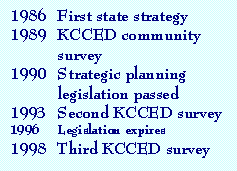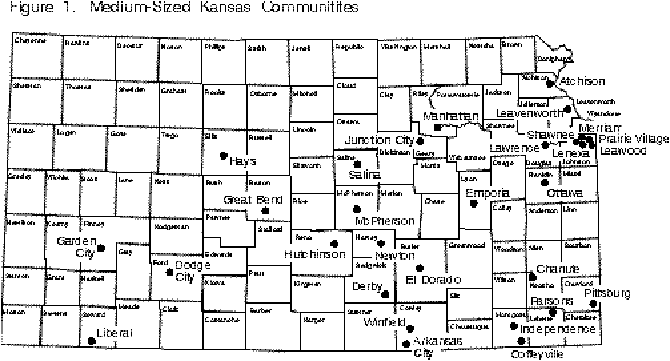Kansas Center for Community Economic Development
Institute for Public Policy and Business Research
The University of Kansas
Economic Development in Medium-Sized
Kansas Communities: 1989 to 1998
Prepared by:
Genna M. Ott
Co-Director, KCCED
Fernando T. Conde
Graduate Research Assistant, KCCED
Charles E. Krider
Director, Institute for Public Policy and Business Research
The University of Kansas
Report No. 255
May 1999
Acknowledgments
The Kansas Center for Community Economic Development is funded by a grant from the U.S. Department of Commerce, Economic Development Administration. The statements, findings, conclusions, recommendations and other data in this report are solely those of the authors and do not necessarily reflect the views of the United States Government, the University of Kansas, or any other individual or organization.
Special thanks and gratitude go to the community leaders who took the time to participate in the survey. Special thanks also go to Charles Krider, Director, Institute for Public Policy and Business Research and Thelma Helyar, Research Assistant, Institute for Public Policy and Business Research.
Institute for Public Policy and Business Research
The University of Kansas
Economic Development in Medium-Sized
Kansas Communities: 1989 to 1998
Prepared by:
Genna M. Ott
Co-Director, KCCED
Fernando T. Conde
Graduate Research Assistant, KCCED
Charles E. Krider
Director, Institute for Public Policy and Business Research
The University of Kansas
Report No. 255
May 1999
Acknowledgments
The Kansas Center for Community Economic Development is funded by a grant from the U.S. Department of Commerce, Economic Development Administration. The statements, findings, conclusions, recommendations and other data in this report are solely those of the authors and do not necessarily reflect the views of the United States Government, the University of Kansas, or any other individual or organization.
Special thanks and gratitude go to the community leaders who took the time to participate in the survey. Special thanks also go to Charles Krider, Director, Institute for Public Policy and Business Research and Thelma Helyar, Research Assistant, Institute for Public Policy and Business Research.
Table of Contents
List of Tables and Figures
Executive Summary
List of Tables and Figures
|
Figure 1 |
Medium-Sized Kansas Communities: Map | 3 |
|
Table 1 |
Organization Interviewed and Organization Primarily Responsible for Economic Development: 1998 | 4 |
|
Table 2 |
Organization Interviewed: 1989, 1993, and 1998 | 5 |
|
Table 3 |
Organization Primarily Responsible for Economic Development: 1989, 1993, and 1998 | 5 |
|
Table 4 |
Community Economic Development Leaders: 1998 | 6 |
|
Table 5 |
Economic Development Directors: 1998 | 7 |
|
Table 6 |
Role of City Government: 1989, 1993, and 1998 | 9 |
|
Table 7 |
Role of Chamber of Commerce: 1989, 1993, and 1998 | 9 |
|
Table 8 |
Role of County Government: 1989, 1993, and 1998 | 10 |
|
Table 9 |
Change in Funding Sources: 1989, 1993, and 1998 | 11 |
|
Table 10 |
Economic Development Budgets: 1998 | 12 |
|
Table 11 |
Changes in Annual Economic Development Budgets: 1989, 1993, and 1998 | 13 |
|
Table 12 |
How Cities Finance Economic Development: 1989, 1993, and 1998 | 14 |
|
Table 13 |
Cooperation with Other Cities and Counties: 1993 and 1998 | 15 |
|
Table 14 |
Strategic Planning Efforts: 1993 and 1998 | 17 |
|
Table 15 |
Strategies for Economic Growth: 1989, 1993, and 1998 | 18 |
|
Table 16 |
Change in Resources Devoted to Strategies: 1989, 1993, and 1998 | 19 |
|
Table 17 |
Existing Business Assistance Programs: 1993 and 1998 | 20 |
|
Table 18 |
Use of Financial Incentives: 1993 and 1998 | 21 |
|
Table 19 |
Change in the Use of Incentives: 1989, 1993, and 1998 | 22 |
|
Endnotes to Table 9 |
25 | |
Executive Summary
In May, 1998, the Kansas Center for Community Economic Development (KCCED) at the University of Kansas updated its 1989 and 1993 studies of economic development in medium-sized Kansas communities. The purpose of this update was to identify changes in methods used by communities in organizing, planning, and funding for economic development. Using the questions in the 1989 and 1993 surveys, KCCED conducted telephone interviews with the same thirty communities from the original 1989 study. The following is a summary of the results.
Organizational Structure

 The three organizational models for economic development identified in previous studies - partnership, government, and
chamber of commerce - were also used in 1998. Thirteen (43 percent) of the communities utilize the partnership model,
where a public/private organization takes full or partial leadership in economic development. Eleven (37 percent) of
the communities use the government model, which involves the city, county or multi-government agency taking the lead in
economic development. Nine communities are classified under the chamber model, where the chamber of commerce takes the
lead. There appears to be a trend away from city governments back to more chambers claiming primary responsibility for
economic development.
The three organizational models for economic development identified in previous studies - partnership, government, and
chamber of commerce - were also used in 1998. Thirteen (43 percent) of the communities utilize the partnership model,
where a public/private organization takes full or partial leadership in economic development. Eleven (37 percent) of
the communities use the government model, which involves the city, county or multi-government agency taking the lead in
economic development. Nine communities are classified under the chamber model, where the chamber of commerce takes the
lead. There appears to be a trend away from city governments back to more chambers claiming primary responsibility for
economic development.Twenty-three (77 percent) of the communities surveyed have economic development directors. Nine directors work for economic development organizations, seven directors work for the chamber of commerce, five directors work for the city, and two directors work for multi-government agencies.
 The level of participation by city and county governments and chambers of commerce in community economic development has
increased since 1989. In 1998, all three organizations are more involved in providing leadership, with city government
(90 percent) identified slightly more than the chamber (87 percent). In 28 (93 percent) communities, the city
government provided funds for economic development, making it the leading financial supporter of economic development.
In 1998, the same number of chambers of commerce provided funds for economic development as did in 1989. More cities
are providing funds for economic development in 1998 than in 1993, while the number of chambers providing funds has
remained the same and the number of counties has decreased.
The level of participation by city and county governments and chambers of commerce in community economic development has
increased since 1989. In 1998, all three organizations are more involved in providing leadership, with city government
(90 percent) identified slightly more than the chamber (87 percent). In 28 (93 percent) communities, the city
government provided funds for economic development, making it the leading financial supporter of economic development.
In 1998, the same number of chambers of commerce provided funds for economic development as did in 1989. More cities
are providing funds for economic development in 1998 than in 1993, while the number of chambers providing funds has
remained the same and the number of counties has decreased.Financing Economic Development

 Total funding for economic development in the communities surveyed increased 29 percent, from $3.67 million in 1993 to
$4.73 million in 1998. The public sector continues to be the primary funding source for economic development with 79
percent of the total budget for 1998 coming from city and county sources. The share of funding from city governments
increased from 45 percent in 1989 to 55 percent in 1998. The share of county funds decreased from 38 percent in 1989 to
24 percent in 1998. In 1998, nine cities (30 percent) reported that they have a city mill levy to support public
economic development activities, while eleven cities (37 percent) reported that their county had a mill levy specially
designated to support economic development activities. Two communities did not designate any money for economic
development in 1998.
Total funding for economic development in the communities surveyed increased 29 percent, from $3.67 million in 1993 to
$4.73 million in 1998. The public sector continues to be the primary funding source for economic development with 79
percent of the total budget for 1998 coming from city and county sources. The share of funding from city governments
increased from 45 percent in 1989 to 55 percent in 1998. The share of county funds decreased from 38 percent in 1989 to
24 percent in 1998. In 1998, nine cities (30 percent) reported that they have a city mill levy to support public
economic development activities, while eleven cities (37 percent) reported that their county had a mill levy specially
designated to support economic development activities. Two communities did not designate any money for economic
development in 1998.Cooperation and Economic Development

 More cities report that they are working more with other cities, with their county, and with other counties in their
economic development efforts than they had in the past. In 1998, twenty-eight (93 percent) reported that their
communities worked with other cities as part of their economic development efforts. Twenty-five (83 percent) said that
they work with the county in economic development efforts, and fifteen (50 percent) reported that they work with several
counties.
More cities report that they are working more with other cities, with their county, and with other counties in their
economic development efforts than they had in the past. In 1998, twenty-eight (93 percent) reported that their
communities worked with other cities as part of their economic development efforts. Twenty-five (83 percent) said that
they work with the county in economic development efforts, and fifteen (50 percent) reported that they work with several
counties.Strategic Planning

 The number of communities with strategic plans increased from twenty in 1993 to twenty-five in 1998. Communities
commonly used citizen surveys, open meetings, consultants and, especially, advisory committees in their strategic
planning process. Economic development organizations were responsible for developing strategic plans for ten (37
percent) communities surveyed while five communities (16 percent) reported that the city government was responsible for
the planning process. All twenty-five communities with strategic plans are currently implementing their plans. Twelve
communities (40 percent) appointed economic development organizations with the implementation of these strategic
plans.
The number of communities with strategic plans increased from twenty in 1993 to twenty-five in 1998. Communities
commonly used citizen surveys, open meetings, consultants and, especially, advisory committees in their strategic
planning process. Economic development organizations were responsible for developing strategic plans for ten (37
percent) communities surveyed while five communities (16 percent) reported that the city government was responsible for
the planning process. All twenty-five communities with strategic plans are currently implementing their plans. Twelve
communities (40 percent) appointed economic development organizations with the implementation of these strategic
plans.Economic Development Strategies

 Many communities would rather not name a single, primary strategy for economic development but prefer a balanced
approach between recruiting, retaining and assisting new firm creation. However, when pressed to choose one strategy as
primary, fourteen communities (47 percent) reported that they focus primarily on existing business retention and
assisting in expansion. Communities are spending more time and resources on recruiting outside businesses and assisting
entrepreneurs in 1998 than in 1993. Eighty percent of those surveyed in 1998 reported that their communities had a
program in place to assist existing businesses.
Many communities would rather not name a single, primary strategy for economic development but prefer a balanced
approach between recruiting, retaining and assisting new firm creation. However, when pressed to choose one strategy as
primary, fourteen communities (47 percent) reported that they focus primarily on existing business retention and
assisting in expansion. Communities are spending more time and resources on recruiting outside businesses and assisting
entrepreneurs in 1998 than in 1993. Eighty percent of those surveyed in 1998 reported that their communities had a
program in place to assist existing businesses.Economic Development Efforts

 All but two of the communities surveyed have used financial incentives in the past two years to encourage economic
development. The range of incentives varied, with the most frequent being the issuance of tax abatements (83 percent),
followed by tax-exempt bonds (73 percent), and infrastructure development (70 percent). Among the remaining financial
incentives, donation of unused real property saw the greatest growth in frequency of use since 1993. Loan subsidies,
sale-leaseback, tax-exempt bonds, and infrastructure development saw decreased use as a financial incentive.
All but two of the communities surveyed have used financial incentives in the past two years to encourage economic
development. The range of incentives varied, with the most frequent being the issuance of tax abatements (83 percent),
followed by tax-exempt bonds (73 percent), and infrastructure development (70 percent). Among the remaining financial
incentives, donation of unused real property saw the greatest growth in frequency of use since 1993. Loan subsidies,
sale-leaseback, tax-exempt bonds, and infrastructure development saw decreased use as a financial incentive.Introduction
With the development of a state strategy for economic development in 1986 (Redwood and Krider, 1986), communities in Kansas started to become more organized in their efforts to increase jobs.

 Economic development
organizations emerged and funds were designated specifically to these efforts. Communities found themselves competing
more with other communities (both in and out of state) to attract new jobs and retain existing ones by offering
incentives, such as tax abatements, enterprise zones, training programs and other business programs.
Economic development
organizations emerged and funds were designated specifically to these efforts. Communities found themselves competing
more with other communities (both in and out of state) to attract new jobs and retain existing ones by offering
incentives, such as tax abatements, enterprise zones, training programs and other business programs.In 1989 the Kansas Center for Community Economic Development (KCCED) at the University of Kansas conducted a study of medium-sized communities to determine how they organize, finance and plan economic development activities (Ott and Skalla, 1989). Few of the communities surveyed at that time were engaged in strategic planning for economic development. However, in 1990 the Kansas Legislature passed the Community Strategic Planning Assistance Act to help counties develop strategic plans and finance action elements of those plans.
Since the passage of the Act, strategic planning in Kansas has increased and Kansas communities have begun to assume greater responsibility for economic development (Ott and Tatarko, 1992). Consequently, the thirty communities surveyed in 1989 were re-surveyed in 1993 and again in 1998 to update information on the status of economic development in Kansas and to determine how they have adapted to the changing business environment in the state.

 This report discusses the results of the 1998 survey and investigates what medium-sized Kansas communities are doing to
encourage economic development and how their efforts may have changed from 1989 to the present. Specifically, this
report looks at organization, finance, cooperation, strategic planning, strategies, and activities and incentives for
each of the thirty communities.
This report discusses the results of the 1998 survey and investigates what medium-sized Kansas communities are doing to
encourage economic development and how their efforts may have changed from 1989 to the present. Specifically, this
report looks at organization, finance, cooperation, strategic planning, strategies, and activities and incentives for
each of the thirty communities.Methodology
Telephone Survey
A telephone survey was administered to 30 medium-sized cities across Kansas (Figure 1). According to the 1996 Census figures, the cities included in the survey ranged in population from 9,248 (Chanute) to 71,887 (Lawrence). Most of the cities are located in the eastern half of the state, with only five located in western Kansas. Eight of the cities are located in or adjacent to urbanized areas: Derby, Lawrence, Leavenworth, Leawood, Lenexa, Merriam, Prairie Village, and Shawnee. In addition, El Dorado and Newton are located in the outlying counties of the Wichita Metropolitan Statistical Area. The remaining twenty cities are situated in predominantly rural areas.

 For each community, initial contact for the survey was made with the city manager or city administrator. In cases where
the city manager or administrator was not the economic development expert for the community, he or she referred
researchers to the person most knowledgeable in the cityís economic development effort. The analysis for this report is
based on one interview for each community. Table 1 lists the organization interviewed for
each city as well as the organization designated as primarily responsible for economic development.
For each community, initial contact for the survey was made with the city manager or city administrator. In cases where
the city manager or administrator was not the economic development expert for the community, he or she referred
researchers to the person most knowledgeable in the cityís economic development effort. The analysis for this report is
based on one interview for each community. Table 1 lists the organization interviewed for
each city as well as the organization designated as primarily responsible for economic development.Of the thirty organizations interviewed, ten (one third) were city governments although only five city governments were designated as primarily or jointly responsible for economic development (Table 1). Their interviews can be justified by recognizing that city governments are active partners in economic development either through the public/private corporations or multi-government agencies and/or as major contributors to the economic development budgets.
Table 2 compares the organizations interviewed in 1998 to those interviewed in 1989 and 1993. Fewer city governments were interviewed in 1998 than in 1993. Two more chambers of commerce, public-private non-profit corporations, and multi-government agencies were interviewed in 1998 than in 1993.
Budget Survey
During the telephone interview, a special effort was made to obtain the 1998 economic development budgets for each community. Besides a request for a budget amount during the interview, letters were sent to all communities in May 1998 requesting budget information. Additional phone calls were also made to clarify some of the amounts.
Source: KCCED/IPPBR, 1993 Survey of Medium-Sized Kansas Communities.
Organizational Structure of Economic Development

 In previous surveys, KCCED found that the organizational structure for encouraging economic development can be
classified according to three models: government, chamber of commerce, and partnership. These models were again the
major economic development models in 1998, with the most common being the partnership model
(Tables 3 and 4).
In previous surveys, KCCED found that the organizational structure for encouraging economic development can be
classified according to three models: government, chamber of commerce, and partnership. These models were again the
major economic development models in 1998, with the most common being the partnership model
(Tables 3 and 4).Partnership Model
The partnership model involves a public/private corporation taking the lead in the communityís economic development effort. The organization can be either not-for-profit or for-profit. In some cities it is called an economic development corporation, in others a commission and in still others a council. No matter what the organizationís title, it is a partnership between the government (city and/or county) and the private sector. There are thirteen communities (43 percent) classified under the partnership model in 1998 (Table 4). In 1993, fifteen communities were classified under the partnership model.
|
Table 1. Organization Interviewed and Organization Primarily Responsible for Economic Development: 1998 |
||
| City |
Organization Interviewed |
Organization Primarily Responsible |
| Arkansas City | Multi-Government | Multi-Government |
| Atchison | Chamber | Chamber |
| Chanute | City | City |
| Coffeyville | City | Public/Private Non-Profit |
| Derby | City | Chamber |
| Dodge City | Pub/Priv Non-Profit | Public/Private Non-Profit |
| El Dorado | Pub/Priv Non-Profit | Public/Private Non-Profit |
| Emporia | City | Multi-Government |
| Garden City | Pub/Priv Non-Profit | Public/Private Non-Profit |
| Great Bend | Multi-Government | Multi-Government |
| Hays | Pub/Priv Non-Profit | Public/Private Non-Profit |
| Hutchinson | Pub/Priv Non-Profit | Public/Private Non-Profit |
| Independence | Chamber | Chamber & Public/Private Non-profit |
| Junction City | Multi-Government | Multi-Government |
| Lawrence | Chamber | Chamber |
| Leavenworth | Pub/Priv Non-Profit | Public/Private Non-Profit |
| Leawood | City | City & Chamber |
| Lenexa | Chamber | Chamber |
| Liberal | City | Public/Private Non-Profit |
| Manhattan | Chamber | Chamber |
| McPherson | Pub/Priv For-Profit | Public/Private For-Profit |
| Merriam | City | City |
| Newton | Pub/Priv Non-Profit | Public/Private Non-Profit |
| Ottawa | Chamber | Public/Private Non-Profit |
| Parsons | City | City |
| Pittsburg | City | City |
| Prairie Village | City | Public/Private Non-Profit |
| Salina | Chamber | Chamber |
| Shawnee | Chamber | Chamber |
| Winfield | Multi-Government | Multi-Government |
|
Source: 1998 Community Survey, KCCED, IPPBR, the University of Kansas, 1999. |
||
|
Table 2. Organization Interviewed: 1989, 1993, and 1998 |
|||
| Organization Interviewed | 1989 | 1993 | 1998 |
| City Government | 13 | 16 | 10 |
| Chamber of Commerce | 8 | 6 | 8 |
| Multi-Government Agency | 1 | 2 | 4 |
| Public/Private Partnerships: |
|
|
|
| Non-profit Corporation | 7 | 5 | 7 |
| For-profit Corporation | 1 | 1 | 1 |
| Total | 30 | 30 | 30 |
|
Source: 1989, 1993 and 1998 Community Surveys, KCCED, IPPBR, the University of Kansas, 1999. |
|||
|
Table 3. Organization Primarily Responsible for Economic Development: 1989, 1993, and 1998 |
|||
| Organization | 1989 | 1993 | 1998 |
| City Government | 8 | 5 | 4 |
| Chamber of Commerce | 9 | 4 | 7 |
| Multi-Government Agency | 2 | 5 | 5 |
| Public/Private Partnerships: |
|
|
|
| Non-profit Corporation | 10 | 11 | 11 |
| For-profit Corporation | 1 | 1 | 1 |
| Advisory Council | -- | 2 | -- |
| Combination* | -- | 1 | 2 |
| No organization | -- | 1 | -- |
| Total | 30 | 30 | 30 |
|
* Both the Chamber of Commerce and a Public/Private Non-profit Corporation share responsibility for economic development in the City of Independence. In the City of Leawood, the city and chamber share responsibility. Source: 1989, 1993 and 1998 Community Surveys, KCCED, IPPBR, the University of Kansas, 1999. |
|||
|
Table 4. Community Economic Development Leaders: 1998 |
|
|
Primary Economic Development Organization |
Cities |
| Government Model: |
|
| City Government |
Chanute, Leawood*, Merriam, Parsons, Pittsburg |
| Multi-government |
Arkansas City, Emporia, Great Bend, Junction City, Winfield |
| Chamber Model: |
|
| Chamber of Commerce |
Atchison, Derby, Independence*, Lawrence, Leawood*, Lenexa, Manhattan, Salina, Shawnee |
| Partnership Model: |
|
| Public/Private Non- Profit |
Coffeyville, Dodge City, El Dorado, Garden City, Hays, Hutchinson, Independence*, Leavenworth, Liberal, Newton, Ottawa, Prairie Village |
| Public/Private For-Profit | McPherson |
| * Independence listed both the chamber and public/private non-profit corporation (Montgomery County Action Council) as primarily responsible for economic development in the community. Leawood listed both city and chamber as primarily responsible. Source: 1998 Community Survey, KCCED, IPPBR, the University of Kansas, 1999. |
|
Of those 13 partnership communities in 1998, nine have a full-time director for economic development. Five economic development directors work for a public/private partnership, two directors work for the city, one director works for the chamber and one works for a multi-government agency (Tables 4 and 5).
Government Model
In the government model, the city government or a multi-government agency formed by both city and county governments provides economic development leadership. Ten (33 percent) of the communities surveyed employ the government model (Table 4). In half of these communities, the city government was primarily responsible for economic development, and, in the other half, a multi-government agency had primary responsibility. Notably, in 1998 as in 1993, there are no medium-sized communities where the county government is solely responsible for economic development.
|
Table 5. Economic Development Directors and for Whom They Work: 1998 |
||
|
City Has a Director |
Organization Director Works for |
Organization Primarily Responsible |
| Arkansas City | Econ Dev Organization | Multi-Government |
| Atchison | Chamber | Chamber |
| Chanute | City | City |
| Coffeyville | City | Public/Private Non-Profit |
| Dodge City | Pub/Priv Non-Profit | Econ Dev Organization |
| Emporia | Econ Dev Organization | Multi-Government |
| Garden City | Econ Dev Organization | Public/Private Non-Profit |
| Great Bend | Econ Dev Organization | Multi-Government |
| Hays | Econ Dev Organization | Public/Private Non-Profit |
| Hutchinson | Econ Dev Organization | Public/Private Non-Profit |
| Junction City | Multi-Government | Multi-Government |
| Lawrence | Chamber | Chamber |
| Lenexa | Chamber | Chamber |
| Liberal | City | Public/Private Non-Profit |
| Manhattan | Chamber | Chamber |
| McPherson | Econ Dev Organization | Public/Private For-Profit |
| Newton | Multi-Government | Public/Private Non-Profit |
| Ottawa | Chamber | Public/Private Non-Profit |
| Parsons | City | City |
| Pittsburg | City | City |
| Salina | Chamber | Chamber |
| Shawnee | Chamber | Chamber |
| Winfield | Econ Dev Organization | Multi-Government |
|
Source: 1998 Community Survey, KCCED, IPPBR, the University of Kansas, 1999. |
||
Of the ten communities under the government model, eight have economic development directors (Table 5). Three directors work for the city government, four directors work for an economic development organization, and one director works for a multi-government agency.
Chamber Model
The chamber of commerce model consists of the chamber of commerce taking the leadership role in economic development. Nine communities fit into the chamber model (Table 4) (1). Under this model, the economic development director works for the chamber. Six of the nine chamber model communities had an economic development director (Table 5). All six directors report directly to the chamber of commerce. In one of the communities with no director, there was also no budget for economic development.
Economic Development Directors

 Twenty-three of the thirty communities surveyed responded that they have economic development directors
Table 5) (2). Nine directors work for economic development organizations, five directors work
for cities, seven directors work for chambers of commerce, and two directors work for multi-government agencies. The
city (73 percent), followed by the county (47 percent) and then the chamber (23 percent) help finance the economic
development director positions.
Twenty-three of the thirty communities surveyed responded that they have economic development directors
Table 5) (2). Nine directors work for economic development organizations, five directors work
for cities, seven directors work for chambers of commerce, and two directors work for multi-government agencies. The
city (73 percent), followed by the county (47 percent) and then the chamber (23 percent) help finance the economic
development director positions.Levels of Participation

 The level of participation in community economic development by city and county governments and the chambers of commerce
has increased. More communities are working cooperatively within their community and are providing leadership for
economic development. However, fewer communities reported that the city, county, and chamber have a staff devoted to
economic development.
The level of participation in community economic development by city and county governments and the chambers of commerce
has increased. More communities are working cooperatively within their community and are providing leadership for
economic development. However, fewer communities reported that the city, county, and chamber have a staff devoted to
economic development.In 1998 cities were seen as the leading and most active agents of economic development in most communities. This is consistent with what was found in 1989 and 1993 (Tables 6, 7, and 8). Cities were reported most often as a provider of leadership (90 percent) and financing (93 percent) for economic development. Chambers of commerce were more likely to employ full-time staff for economic development duties than cities (53 percent for chambers and 30 percent for cities). However, all three entities -- city, chamber and county -- were generally perceived as willing to cooperate with each other when working to advance development in their communities.
|
Table 6. Role of City Government in Economic Development: 1989, 1993, and 1998 |
||||||
| Role | 1989 | 1993 | 1998 | |||
| No. | Pct. | No. | Pct. | No. | Pct. | |
| Provides Leadership | 7 | 23.3% | 23 | 76.7% | 27 | 90.0% |
| Staff Devoted to Econ. Dev. | 4 | 13.3 | 16 | 53.3 | 9 | 30.0 |
| Works with the County | 6 | 20.0 | 26 | 86.7 | 24 | 80.0 |
| Works with the Chamber | 11 | 36.7 | 27 | 90.0 | 27 | 90.0 |
| Provides financing | 24 | 80.0 | 28 | 93.3 | 28 | 93.3 |
| Other* | 20 | 66.7 | 18 | 60.0 | 3 | 10.0 |
|
* Other includes: producing brochures and promotional information, tax incentives, infrastructure improvements, networks with Kansas Department of Commerce and Housing (KDOC&H) and Kansas City area development councils, partners and supports, coordinates with other organizations, etc. Source: 1989, 1993 and 1998 Community Surveys, KCCED, IPPBR, the University of Kansas, 1999. |
||||||
|
Table 7. Role of Chamber of Commerce in Economic Development: 1989, 1993, and 1998 |
||||||
| Role | 1989 | 1993 | 1998 | |||
| No. | Pct. | No. | Pct. | No. | Pct. | |
| Provides Leadership | 11 | 36.7% | 20 | 67.7% | 26 | 86.7% |
| Staff Devoted to Econ. Dev. | 12 | 40.0 | 18 | 60.0 | 16 | 53.3 |
| Works with the County | 15 | 50.0 | 25 | 83.3 | 24 | 80.0 |
| Works with the Chamber | 5 | 16.7 | 28 | 93.3 | 29 | 96.7 |
| Provides financing | 8 | 26.7 | 10 | 33.3 | 10 | 33.3 |
| Other* | 13 | 43.3 | 10 | 33.3 | 1 | 3.4 |
|
Other includes provides staff, provides office administration, coordinates marketing, and provides secretarial support. Source: 1989, 1993 and 1998 Community Surveys, KCCED, IPPBR, the University of Kansas, 1999. |
||||||
|
Table 8. Role of County Government in Economic Development: 1989, 1993, and 1998 |
||||||
| Role | 1989 | 1993 | 1998 | |||
| No. | Pct. | No. | Pct. | No. | Pct. | |
| Provides Leadership | 2 | 6.7% | 13 | 43.3% | 20 | 66.7% |
| Staff Devoted to Econ. Dev. | 1 | 3.3 | 9 | 30.0 | 4 | 13.3 |
| Works with the County | 7 | 23.3 | 28 | 93.3 | 23 | 76.7 |
| Works with the Chamber | 6 | 20.0 | 23 | 76.7 | 22 | 73.3 |
| Provides financing | 13 | 43.3 | 25 | 83.3 | 22 | 73.3 |
| Other* | 16 | 53.3 | 8 | 26.7 | 2 | 6.7 |
|
Other includes industrial recruitment, assistance with industrial park development, advertising, marketing, tax abatements, etc. Source: 1989, 1993 and 1998 Community Surveys, KCCED, IPPBR, the University of Kansas, 1999. |
||||||

 The number of chambers of commerce providing leadership has increased from eleven (20 percent) in 1989, to twenty
(68 percent) in 1993, and to twenty-six (87 percent) in 1998. Although survey respondents frequently reported county
governments as providers of financing, the number of counties providing financing has declined from twenty-five
(83 percent) in 1993 to twenty-two (73 percent) in 1998. Consequently, city governments are increasing their share of
funds to support economic development, from 48 percent in 1993 to 55 percent in 1998
(Table 9).
The number of chambers of commerce providing leadership has increased from eleven (20 percent) in 1989, to twenty
(68 percent) in 1993, and to twenty-six (87 percent) in 1998. Although survey respondents frequently reported county
governments as providers of financing, the number of counties providing financing has declined from twenty-five
(83 percent) in 1993 to twenty-two (73 percent) in 1998. Consequently, city governments are increasing their share of
funds to support economic development, from 48 percent in 1993 to 55 percent in 1998
(Table 9).Leadership

 Since 1989, economic development leadership has increased at all levels in Kansasí medium-sized communities. Four more
cities, seven more counties, and six more chambers were reported to provide leadership for economic development in 1998
than in 1989 (Tables 6, 7, and 8). All three
surveys (1989, 1993, and 1998) found the city more likely to provide leadership than the county and the chamber of
commerce. In all three surveys, county governments were least likely to provide leadership for economic development.
Since 1989, economic development leadership has increased at all levels in Kansasí medium-sized communities. Four more
cities, seven more counties, and six more chambers were reported to provide leadership for economic development in 1998
than in 1989 (Tables 6, 7, and 8). All three
surveys (1989, 1993, and 1998) found the city more likely to provide leadership than the county and the chamber of
commerce. In all three surveys, county governments were least likely to provide leadership for economic development.|
Table 9. Change in Funding Sources (Percent of Total): 1989, 1993 and 1998 |
|||||
| Year | Budget | City | County | Private | Other |
| 1989 | $2,663,335 | 45.1% | 38.2% | 13.3% | 2.9% |
| 1993 | $3,671,553 | 47.7% | 28.2% | 14.2% | 10.6% |
| 1998 | $4,726,832 | 54.6% | 24.1% | 14.0% | 7.4% |
|
Does not include Arkansas City, Derby, Dodge City, Leawood, Merriam, Parsons, Prairie Village, Shawnee and Winfield, which were not part of the 1989 Financial Survey. Source: 1989, 1993 and 1998 Community Surveys, KCCED, IPPBR, the University of Kansas, 1999. |
|||||
Financing Economic Development
 The 1989 study found that despite its relatively low-profile leadership role, the public sector was primarily
responsible for financing economic development efforts (Krider, Ott, and Skalla, 1989). In 1998 the public sector
continues to have a high-profile leadership role, particularly city government, and continues to be primarily
responsible for financing economic development efforts (Table 9).
The 1989 study found that despite its relatively low-profile leadership role, the public sector was primarily
responsible for financing economic development efforts (Krider, Ott, and Skalla, 1989). In 1998 the public sector
continues to have a high-profile leadership role, particularly city government, and continues to be primarily
responsible for financing economic development efforts (Table 9).Budgets
The 1998 budgets for economic development ranged from $0 to $273,000 (Table 10). Two communities reported no budget for economic development. Thirteen communities reported budgets greater than $200,000. The average 1998 economic development budget for a medium-sized community was $162,994. In general, the larger the community (greater population), the higher the budget. The average budget for a city with over 30,000 population was $ 210,077, while the average budget for a city with less than 15,000 population was $134,006. The average budget for communities between 15,000 and 30,000 population was $159,686.
For 1998, the total dollars budgeted for the cities surveyed were approximately $4.73 million compared to $3.67 million in 1993 -- a 29 percent increase (Table 10). Arkansas City/ Winfield, Emporia, Manhattan, Prairie Village, and Shawnee enjoyed economic development budget increases of 50 percent or more from 1993 to 1998 (Table 11). Eight cities reported decreased budgets from 1993 to 1998.
|
Table 10. Economic Development Budgets: 1998 (i) |
|||||
| City | Budget | City | County | Private | Other |
| Population over 30,000 | |||||
| Lawrence | $ 246,501 | $ 74,167 | $ 74,167 | $ 98,167 | $ --- |
| Salina | 273,000 | 85,000 | 15,000 | 173,000 | --- |
| Leavenworth | 153,000 | 58,000 | 50,000 | 36,000 | 9,000 |
| Shawnee | 196,133 | 173,047 | --- | 19,000 | 4,086 |
| Hutchinson | 92,100 | 22,500 | 60,000 | 9,600 | --- |
| Manhattan | 263,000 | 120,000 | 42,000 | 101,000 | --- |
| Lenexa | 246,807 | 211,807 | --- | 35,000 | --- |
| Population 20,000 to 30,000 | |||||
| Emporia | 209,726 | 209,726 | --- | --- | --- |
| Garden City | 231,756 | 40,000 | 120,000 | --- | 71,756 |
| Leawood | --- | --- | --- | --- | --- |
| Prairie Village | 25,000 | 15,000 | --- | --- | 10,000 |
| Dodge City | 209,900 | 91,210 | 30,000 | 63,190 | 25,500 |
| Junction City | 220,000 | 134,000 | 90,000 | --- | --- |
| Population 15,000 to 20,000 | |||||
| Pittsburg | 126,100 | 126,100 | --- | --- | --- |
| Hays | 213,560 | 63,000 | 60,000 | 53,712 | 36,848 |
| Newton | 248,839 | 107,156 | 66,800 | --- | 74,883 |
| Liberal | 216,450 | 206,450 | 10,000 | --- | --- |
| Derby | --- | --- | --- | --- | --- |
| Great Bend | 214,900 | 69,400 | 145,000 | --- | 500 |
| Population less than 15,000 | |||||
| Merriam | 75,000 | 75,000 | --- | --- | --- |
| McPherson | 46,000 | 23,000 | 23,000 | --- | --- |
| Arkansas City/Winfield | 135,000 | 40,000 | 20,000 | --- | 75,000 |
| Coffeyville/Independence | 158,100 | 32,000 | 97,000 | 26,000 | 3,100 |
| Independence | 123,376 | 123,376 | --- | --- | --- |
| El Dorado | 243,250 | 44,000 | 155,000 | 44,000 | 250 |
| Parsons | 204,000 | 204,000 | --- | --- | --- |
| Ottawa | 95,045 | 50,000 | 32,000 | 2,000 | 11,045 |
| Atchison | 169,500 | 90,000 | 50,000 | --- | 29,500 |
| Chanute | 90,790 | 90,790 | --- | --- | --- |
|
|
|||||
| Total | $ 4,726,832 | $ 2,578,729 | $ 1,139,967 | $ 660,669 | $ 351,467 |
| Percent of Total |
|
54.6% | 24.1% | 14.0% | 7.4% |
|
See Endnotes for further information about budgets and their sources. Source: 1998 Community Survey, KCCED, IPPBR, the University of Kansas, 1999. |
|||||
|
Table 11. Changes in Annual Economic Development Budgets: 1989, 1993, and 1998 |
|||||
| City | 1989 | 1993 | 1998 | 1993-1998 | 1989-1998 |
| Arkansas City/ | $ * | $ 4,000 | $ --- | $ N/A | $ N/A |
| Winfield** | * | 15,000 | 135,000 | 116,000 | N/A |
| Atchison | 94,100 | 100,775 | 169,5000 | 58,725 | 75,4000 |
| Chanute | 48,500 | 83,050 | 90,790 | 7,740 | 42,290 |
| Coffeyville/ Independence | 103,000 | 142,500 | 158,100 | 15,600 | 55,100 |
| Derby | * | 70,000 | 0 | (70,000) | N/A |
| Dodge City | * | 139,468 | 209,900 | 70,432 | N/A |
| El Dorado | 189,000 | 242,200 | 243,250 | (1,050) | (54,250) |
| Emporia | 72,365 | 105,000 | 209,726 | 104,726 | 137,361 |
| Garden City | 100,000 | 151,387 | 231,756 | 80,369 | 131,756 |
| Great Bend | 131,500 | 227,000 | 214,900 | (12,100) | 83,400 |
| Hays | 198,270 | 212,000 | 213,560 | 1,560 | 15,290 |
| Hutchinson | 215,000 | 227,255 | 92,100 | (135,155) | (122,900) |
| Junction City | 175,000 | 260,000 | 220,000 | (40,000) | 45,000 |
| Lawrence | 130,000 | 171,000 | 246,501 | 75,501 | 116,501 |
| Leavenworth | 100,000 | 109,440 | 153,000 | 43,560 | 53,000 |
| Leawood | * | 15,000 | 0 | (15,000) | N/A |
| Lenexa | 163,000 | 167,212 | 246,807 | 79,595 | 83,807 |
| Liberal | 80,000 | 145,609 | 216,450 | 70,841 | 136,450 |
| Manhattan | 180,000 | 130,000 | 263,000 | 133,000 | 83,000 |
| McPherson | 125,000 | 77,000 | 46,000 | (31,000) | (79,000) |
| Merriam | * | 104,000 | 75,000 | (29,000) | N/A |
| Newton | 154,000 | 174,836 | 248,839 | 74,003 | 94,839 |
| Ottawa | 84,000 | 86,000 | 95,045 | 9,045 | 11,045 |
| Parsons | * | 140,000 | 204,000 | 64,000 | N/A |
| Pittsburg | 151,000 | 134,521 | 126,100 | (8,421) | (24,900) |
| Prairie Village | * | 0 | 25,000 | 25,000 | N/A |
| Salina | 169,600 | 187,500 | 273,000 | 85,500 | 103,400 |
| Shawnee | * | 40,000 | 196,133 | 156,133 | N/A |
|
* City was not part of 1989 financial survey and therefore data are not available. N/A: Not Applicable; can not calculate net change from 1989 to 1998. ** Arkansas City combined economic development efforts with Winfield by 1998. Source: 1989, 1993, and 1998 Community Surveys, KCCED, IPPBR, the University of Kansas, 1999. |
|||||
Sources of Financing
Of the total budget amount for 1998, approximately 55 percent came from city government sources, 24 percent from county government, 14 percent from private, and 7 percent from other sources (Table 9). In 1993, 48 percent came from city sources, 28 percent county, 14 percent private, and 11 percent from other.

 In 1998, twelve cities (40 percent) reported relying on general tax revenues to support economic development compared to
22 cities (73 percent) in 1993 (Table 12). Several cities also have a special sales tax to
help fund economic development. Other financial sources mentioned in addition to special and general tax revenues were
transient guest taxes, federal grants, and special benefit district bonds. Nine respondents (30 percent) reported that
their communities have a city property tax mill levy specially designated to support economic development activities.(3)
Eleven communities reported financing their budgets with a county mill levy.(4)
In 1998, twelve cities (40 percent) reported relying on general tax revenues to support economic development compared to
22 cities (73 percent) in 1993 (Table 12). Several cities also have a special sales tax to
help fund economic development. Other financial sources mentioned in addition to special and general tax revenues were
transient guest taxes, federal grants, and special benefit district bonds. Nine respondents (30 percent) reported that
their communities have a city property tax mill levy specially designated to support economic development activities.(3)
Eleven communities reported financing their budgets with a county mill levy.(4)|
Table 12. How Cities finance Economic Development: 1989, 1993, and 1998 |
||||||
| Source of Financing | 1989 | 1993 | 1998 | |||
| No. | Pct. | No. | Pct. | No. | Pct. | |
| General Tax Revenues | 16 | 53.3% | 22 | 73.3% | 12 | 40.0% |
| Special Tax Revenues | 7 | 23.3 | 9 | 30.0 | 6 | 20.0 |
| Combination Special and General | 1 | 3.3 | 8 | 26.7 | 8 | 26.7 |
| Other | 1 | 3.3 | 10 | 33.3 | 2 | 6.7 |
|
* Other includes transient guest tax, federal grants, tax abatements, special benefit district bonds, sales tax exemptions, CDBGs, utilities, etc. Source: 1989, 1993, and 1998 Community Surveys, KCCED, IPPBR, the University of Kansas, 1999. |
||||||
The number of communities that had a separate budget specifically for economic development increased from sixteen (53 percent) in 1993 to twenty-four (80 percent) in 1998. Five communities reported off-budget economic development activities. Off-budget items included promotion of tourism, promotion and marketing of industrial parks, research support and contact, seed capital pools, and transportation and highway development.
Cooperation and Economic Development

 Communities are working more cooperatively in their economic development efforts than they have in the past.
Twenty-eight (93 percent) of the communities reported that they worked with other cities as part of their economic
development efforts (Table 13). Twenty-five (83 percent) said that they work with the county
in economic development efforts, and fifteen (50 percent) reported that they work with several counties. These numbers
are all up from the 1993 findings.
Communities are working more cooperatively in their economic development efforts than they have in the past.
Twenty-eight (93 percent) of the communities reported that they worked with other cities as part of their economic
development efforts (Table 13). Twenty-five (83 percent) said that they work with the county
in economic development efforts, and fifteen (50 percent) reported that they work with several counties. These numbers
are all up from the 1993 findings.|
Table 13. Cooperation with Other Cities and Counties: 1993 and 1998 |
||||
| Cooperates with | 1993 | 1998 | ||
| No. | Pct. | No. | Pct. | |
| Other Cities | 25 | 83.3% | 28 | 93.3% |
| County | 19 | 63.3 | 25 | 83.3 |
| Several Counties | 14 | 46.7 | 15 | 50.0 |
|
Source: 1993 and 1998 Community Surveys, KCCED, IPPBR, the University of Kansas, 1999. |
||||
Strategic Planning

 Twenty-five of the communities reported having written strategic plans in place in 1998 while five others have no
strategic plan and are not engaged in any phase of the strategic planning process (Table 14).
This compares with only twenty communities having strategic plans in 1993 (Krider, Ott, and Hamilton, 1993). Communities
surveyed commonly used citizen surveys, open meetings, consultants and, especially, advisory committees in their
strategic planning process.
Twenty-five of the communities reported having written strategic plans in place in 1998 while five others have no
strategic plan and are not engaged in any phase of the strategic planning process (Table 14).
This compares with only twenty communities having strategic plans in 1993 (Krider, Ott, and Hamilton, 1993). Communities
surveyed commonly used citizen surveys, open meetings, consultants and, especially, advisory committees in their
strategic planning process.
 Economic development organizations were most often identified as the entity responsible for strategic planning in the
communities surveyed (Table 14). This was reported to be the case in ten communities in 1993
and eleven communities in 1998. The city government was responsible for developing the strategic plan in five
communities in 1998. County governments were solely responsible for the economic planning efforts in three cities while
the chamber was solely responsible in two cities.
Economic development organizations were most often identified as the entity responsible for strategic planning in the
communities surveyed (Table 14). This was reported to be the case in ten communities in 1993
and eleven communities in 1998. The city government was responsible for developing the strategic plan in five
communities in 1998. County governments were solely responsible for the economic planning efforts in three cities while
the chamber was solely responsible in two cities.
 All twenty-five communities with strategic plans in place in 1998 reported that they were implementing their plans
(Table 14). Economic development organizations were named responsible for plan
implementation in twelve cases. Four city governments, four chambers, and three county governments were also identified
as responsible for implementing strategic plans.
All twenty-five communities with strategic plans in place in 1998 reported that they were implementing their plans
(Table 14). Economic development organizations were named responsible for plan
implementation in twelve cases. Four city governments, four chambers, and three county governments were also identified
as responsible for implementing strategic plans.|
Table 14. Strategic Planning Efforts in Medium-Sized Kansas Communities: 1993 and 1998 |
||||
| Planning Status | 1993 | 1998 | ||
| No. | N=30 | No. | N=30 | |
| Has Written Plan | 20 | 67.7% | 25 | 83.3% |
| No Plan | 3 | 10.0 | 5 | 16.7 |
| Developing Plan | 7 | 23.3 | 0 | 0.0 |
| Implementing Plan | 19 | 63.3 | 25 | 83.3 |
|
|
||||
|
Methods Used by Communities |
No. | N=20 | No. | N=25 |
| Advisory Committees | 20 | 100% | 21 | 84% |
| Open Meetings | 19 | 95 | 21 | 84 |
| Citizen Surveys | 16 | 80 | 17 | 68 |
| Consultants | 15 | 75 | 14 | 56 |
|
|
||||
|
Group Responsible for Developing Plan |
No. | N=27 | No. | N=25 |
| Econ Dev Organization | 10 | 27.0% | 11 | 44.0% |
| City | 1 | 3.7 | 5 | 20.0 |
| County | 0 | 0.0 | 3 | 12.0 |
| Chamber of Commerce | 1 | 3.7 | 2 | 8.0 |
| Task Group/Committee | 6 | 22.2 | 1 | 4.0 |
| Other * | 9 | 33.3 | 3 | 12.0 |
|
|
||||
|
Group Responsible for Implementing Plan |
No. | N=20 | No. | N=25 |
| Econ Dev Organization | 10 | 50% | 12 | 48% |
| City | 2 | 10.0 | 4 | 16 |
| Chamber of Commerce | 2 | 10 | 4 | 16 |
| County | 1 | 5 | 3 | 12 |
| Special Task Group/Committee | 1 | 5 | 0 | 0 |
| Other * | 4 | 20 | 2 | 8 |
|
* Other includes local port authority, city/county/chamber, all of the above, small business development corporation, county/economic development organization, etc. Source: 1993 and 1998 Community Surveys, KCCED, IPPBR, the University of Kansas, 1999. |
||||
Economic Development Strategies

 Fewer communities in 1998 reported having NO strategy than in 1993, suggesting that communities are getting more
focussed in their efforts (Table 15). In general, economic development strategies are to
recruit existing businesses from other locations, to foster creation of new business, and to help existing business
expand. Studies have shown that more (net) new jobs come from existing firms, certain kinds of small businesses, and
new firms than from recruiting branch plants (National Governorsí Association, 1988). In 1993, medium-sized communities
in Kansas were moving away from using recruitment to create new jobs to a more balanced approach that emphasized job
creation from within the community. In 1998, there appears to be a movement back to recruitment as the primary strategy
(Table 15).
Fewer communities in 1998 reported having NO strategy than in 1993, suggesting that communities are getting more
focussed in their efforts (Table 15). In general, economic development strategies are to
recruit existing businesses from other locations, to foster creation of new business, and to help existing business
expand. Studies have shown that more (net) new jobs come from existing firms, certain kinds of small businesses, and
new firms than from recruiting branch plants (National Governorsí Association, 1988). In 1993, medium-sized communities
in Kansas were moving away from using recruitment to create new jobs to a more balanced approach that emphasized job
creation from within the community. In 1998, there appears to be a movement back to recruitment as the primary strategy
(Table 15).Fourteen of communities surveyed in 1998 (47 percent) responded that they are focusing strategies and resources on existing business retention and expansion to encourage economic growth (Table 15). This is an increase of three communities from 1993. Six communities in 1998 identified recruiting outside business as their primary strategy. In 1993, no community had identified this as its primary strategy for economic development. Four communities in 1998 reported employing a combination of recruitment, retention and creation strategy.
|
Table 15. Strategies for Economic Growth in Medium-Sized Kansas Communities: 1989, 1993, and 1998 |
||||||
| Primary Strategy | 1989 | 1993 | 1998 | |||
| No. | Pct. | No. | Pct. | No. | Pct. | |
| Retain/assist existing business | 12 | 40.0% | 11 | 36.7% | 14 | 46.7% |
| Recruit outside business | 6 | 20.0 | 0 | 0.0 | 6 | 20.0 |
| Combination-recruit, retain, and create | 8 | 26.7 | 10 | 33.3 | 4 | 13.3 |
| Assist in creating new business | 0 | 0.0 | 1 | 3.3 | 2 | 6.7 |
| No primary strategy | 4 | 13.3 | 8 | 26.7 | 2 | 6.7 |
|
Source: 1989, 1993, and 1998 Community Surveys, KCCED, IPPBR, the University of Kansas, 1999. |
||||||
Change in Resources Devoted to Strategies

 As shown in Table 16, the resources that communities devoted to each type of strategy,
whether primary or secondary, varied widely both in 1993 and 1998. The reported percentages of resources apportioned to
each type of activity indicate that the emphasis on business retention and expansion has become even more focused. In
1998, on average, over forty-three percent of communitiesí economic development resources are devoted to retention and
expansion of existing businesses.
As shown in Table 16, the resources that communities devoted to each type of strategy,
whether primary or secondary, varied widely both in 1993 and 1998. The reported percentages of resources apportioned to
each type of activity indicate that the emphasis on business retention and expansion has become even more focused. In
1998, on average, over forty-three percent of communitiesí economic development resources are devoted to retention and
expansion of existing businesses.
 Twenty-four (80 percent) of the respondents reported that their communities had a program in place to assist existing
industry (Table 17). Of the twenty-four who identified the components of these programs,
twenty-three stated that personal visits were part of their communityís program. The other most common elements, in
descending order of frequency, included tax incentives, surveys, financial assistance, and export assistance tax
incentives, and surveys. Existing business programs are in the infancy stage in most communities and the exact elements
of such programs have not yet been determined. Existing business programs are not formalized to the extent that
industrial recruitment programs are. Most state and local incentive programs still favor recruitment efforts.
Twenty-four (80 percent) of the respondents reported that their communities had a program in place to assist existing
industry (Table 17). Of the twenty-four who identified the components of these programs,
twenty-three stated that personal visits were part of their communityís program. The other most common elements, in
descending order of frequency, included tax incentives, surveys, financial assistance, and export assistance tax
incentives, and surveys. Existing business programs are in the infancy stage in most communities and the exact elements
of such programs have not yet been determined. Existing business programs are not formalized to the extent that
industrial recruitment programs are. Most state and local incentive programs still favor recruitment efforts.|
Table 16. Change in Resources Devoted to Strategies: 1989, 1993, and 1998 |
|||||||||
| Strategy | 1989 | 1993 | 1998 | ||||||
| Min | Max | Mean | Min | Max | Mean | Min | Max | Mean | |
| Recruit | 5% | 80% | 39.1% | 0% | 75% | 32.1% | 10% | 80% | 33.5% |
| Retain assist | 9 | 90 | 43.5 | 5 | 100 | 43.5 | 15 | 90 | 43.6 |
| Assist entrepreneurs | 0 | 34 | 15.3 | 0 | 50 | 16.9 | 0 | 45 | 18.2 |
|
Source: 1989, 1993, and 1998 Community Surveys, KCCED, IPPBR, the University of Kansas, 1999. |
|||||||||
|
Table 17. Existing Business Assistance Programs in Medium-Sized Communities: 1993 and 1998 |
||||
| Status | 1993 | 1998 | ||
| No. |
Percent N = 30 |
No. |
Percent N = 30 |
|
| Has a Program | 24 | 80% | 24 | 80.0% |
|
|
||||
| Program Consists of: | No. |
Percent N = 23 |
No. |
Percent N = 24 |
| Personal visits | 23 | 100% | 23 | 96% |
| Tax incentives | 15 | 65 | 19 | 79 |
| Financial assistance | 16 | 70 | 17 | 71 |
| Surveys | 15 | 65 | 17 | 71 |
| Training | 17 | 74 | 16 | 67 |
| Export assistance | 10 | 44 | 13 | 54 |
| Other* | 9 | 40 | 1 | 4 |
|
* Other includes: manufacturers round table, "TLC", counseling, management, industrial advisory council, coordination of state agencies, information clearinghouse, other activities as needed - customized to each business, etc. Source: 1993 and 1998 Community Surveys, KCCED, IPPBR, the University of Kansas, 1999. |
||||
Economic Development Efforts

 Most communities try to make themselves attractive to new industries and most encourage current companies to stay in
town. To give themselves what they consider a slight edge, cities offer various incentives, from money, to speculative
buildings, to infrastructure improvements.
Most communities try to make themselves attractive to new industries and most encourage current companies to stay in
town. To give themselves what they consider a slight edge, cities offer various incentives, from money, to speculative
buildings, to infrastructure improvements.Twenty-eight (93 percent) of the communities in 1998 responded "yes" when asked if their city uses financial incentives to encourage economic development (Table 18). Only two communities reported that their city did NOT use financial incentives to encourage economic development.
|
Table 18. Use of Financial Incentives in the Past Two Years: 1993 and 1998 |
||||
| Status | 1993 | 1998 | ||
| No. | Pct. | No. | Pct. | |
| Used Incentives | 26 | 86.7% | 28 | 93.3% |
|
|
||||
|
Incentives Used in the Past Two Years: |
No. | Pct. | No. | Pct. |
| Tax abatements | 22 | 73.3% | 25 | 83.3% |
| Issue tax exempt bonds | 26 | 86.7 | 22 | 73.3 |
| Infrastructure development | 25 | 83.3 | 21 | 70.0 |
| Direct loans to private businesses | 14 | 46.7 | 14 | 46.7 |
| Loan guarantees | 11 | 36.7 | 11 | 36.7 |
| Loan subsidies | 11 | 36.6 | 10 | 33.3 |
| Donation of unused real property | 5 | 16.7 | 10 | 33.3 |
| Direct cash contribution | 7 | 23.3 | 9 | 30.0 |
| Sale-leaseback | 9 | 30.0 | 8 | 26.7 |
| Share equity | 2 | 6.7 | 3 | 10.0 |
|
Source: 1993 and 1998 Survey of Medium-Sized Kansas Communities. KCCED/ IPPBR. |
||||

 The diversity of approaches utilized by the communities has increased since 1989. Tax-exempt bonds, infrastructure
development, and tax abatements remain the leading incentive methods. The use of tax abatements by communities has
increased in frequency from twenty-two in 1993 to twenty-five in 1998 (Table 19). Among the
remaining financial incentives, the greatest growth in use over the four-year period was the donation of unused real
property, which increased from five to ten, an increase of one hundred percent. Loan subsidies, sale-leaseback,
tax-exempt bonds, and infrastructure development decreased in use as a financial incentive.
The diversity of approaches utilized by the communities has increased since 1989. Tax-exempt bonds, infrastructure
development, and tax abatements remain the leading incentive methods. The use of tax abatements by communities has
increased in frequency from twenty-two in 1993 to twenty-five in 1998 (Table 19). Among the
remaining financial incentives, the greatest growth in use over the four-year period was the donation of unused real
property, which increased from five to ten, an increase of one hundred percent. Loan subsidies, sale-leaseback,
tax-exempt bonds, and infrastructure development decreased in use as a financial incentive.|
Table 19. Change in the Use of Economic Development Incentives: 1989, 1993, and 1998 |
|||
|
Economic Development Incentives |
1989 | 1993 | 1998 |
| Tax abatements | 19 | 22 | 25 |
| Issuance of tax-exempt bonds | 19 | 26 | 22 |
| Infrastructure | 21 | 25 | 21 |
| Direct loans to private business | 13 | 14 | 14 |
| Loan guarantees | 8 | 11 | 11 |
| Loan subsidies | 6 | 11 | 10 |
| Donations of unused real property | 9 | 5 | 10 |
| Direct cash contribution | 6 | 7 | 9 |
| Sale-leaseback | 6 | 9 | 8 |
| Shared equity | 1 | 2 | 3 |
|
Source: 1989, 1993, and 1998 Community Surveys, KCCED, IPPBR, the University of Kansas, 1999. |
|||
Conclusions
 All the cities in our survey recognize the need for economic development. Each city, however, defines economic
development according to its own standards, and each is at a different point in creating an economic development
program. Their strategies are diverse. Nevertheless, several conclusions can be drawn from the survey results.
All the cities in our survey recognize the need for economic development. Each city, however, defines economic
development according to its own standards, and each is at a different point in creating an economic development
program. Their strategies are diverse. Nevertheless, several conclusions can be drawn from the survey results.- Medium-sized Kansas communities are split in their organizational approach between three models: government, chamber, and partnership. The public/private partnership approach was the most common model.
- City governments remain a strong advocate of economic development planning through their leadership, involvement in partnership organizations, and increased financial support of economic development activities. City governmentís share of economic development budgets increased from 48 percent in 1993 to 55 percent in 1998.
- County governments still played a participatory role in community economic development although their budget contribution as a percent share of total budgets has declined from 28 percent in 1993 to 24 percent in 1998.
- More chambers of commerce play a leadership role in community economic development efforts with three more communities reporting chambers as the primary economic development organization.
- Financing of economic development has increased in most communities in the past four years and communities are relying more on cities to fund their efforts.
- Communities are taking a more balanced approach to economic development strategies and are allocating less resources to business retention and expansion and new business creation strategies than they had in the past. Six communities claimed recruiting outside industry as its primary economic development strategy in 1998.
- In the 1998 survey, more communities view strategic planning as a critical step to success in community economic development. Local economic development organizations are taking the lead in overseeing the process and implementing the plan.
- Ninety-three percent of communities surveyed (28) are using financial incentives to encourage economic development. The most frequently used incentives are tax abatements, infrastructure development, and tax exempt bonds. Communities are using more incentives than they have in the past.

 In 1998, communities are looking more towards cooperative efforts to accomplish their economic development goals.
Medium-sized Kansas communities have come a long way in the past few years regarding their economic development efforts.
They have adapted their organizations and increased funding to ensure success. More partnerships exist and more
formalized economic development programs have been developed since 1993. Since 1993, communities have learned many
lessons in economic development planning and have modified their organizations and strategies to increase their chance
for success.
In 1998, communities are looking more towards cooperative efforts to accomplish their economic development goals.
Medium-sized Kansas communities have come a long way in the past few years regarding their economic development efforts.
They have adapted their organizations and increased funding to ensure success. More partnerships exist and more
formalized economic development programs have been developed since 1993. Since 1993, communities have learned many
lessons in economic development planning and have modified their organizations and strategies to increase their chance
for success.References
Krider, Charles E., Genna M. Ott, and Patty Skalla. "Economic Development in Medium-Sized Kansas Communities," Kansas Business Review 12, 4 (Summer 1989): 10-16.
National Governorsí Association. New Alliances for Rural America. Washington, D.C.: National Governorsí Association. 1988.
Ott, Genna M., and Patty Skalla. Economic Development in Medium-Sized, Non-Metropolitan Kansas Communities (Report No. 167). Lawrence, Kansas: Institute for Public Policy and Business Research, University of Kansas. July 1989.
Ott, Genna M., and James D. Hamilton. Economic Development in Medium-Sized, Non-Metropolitan Kansas Communities (Report No. 210). Lawrence, Kansas: Institute for Public Policy and Business Research, University of Kansas. November 1993.
Ott, Genna M., and Elizabeth Tatarko. Kansas Community Strategic Plans (Report No. 201). Lawrence, Kansas: Kansas Center for Community Economic Development, Institute for Public Policy and Business Research, University of Kansas. November 1992.
Redwood, Anthony, and Charles E. Krider. Kansas Economic Development Study: Findings, Strategy, and Recommendations. Lawrence, Kansas: Institute for Public Policy and Business Research, University of Kansas. June 1986.
Upmeier, Helga K. Comparison of Economic Development Expenditures in Kansas Communities (Report No. 162). Lawrence, Kansas: Institute for Public Policy and Business Research, University of Kansas. March 1993.
Endnotes
(i) Table 9 Notes:
Arkansas City/Winfield: Budget for the Cowley County Economic Development Agency (CCEDA). City includes $20,000 from Winfield and $20,000 from Arkansas City. Other includes an EDA grant.
Atchison: Economic Development Budget for the Atchison Chamber of Commerce. Other includes carryover and misc. funds.
Chanute: Budget for General Expenditures for Economic Development for the City of Chanute. Does not include $26,000 for Main Street support and $230,000 for Industrial Development.
Coffeyville/Independence: Budget for the Montgomery County Action Council. City includes $14,000 from Independence, $14,000 from Coffeyville, $2,000 from Chaney, and $2,000 from Cherryvale. Does not include $25,000 from RDA (Dept. of Agriculture) to establish a revolving loan fund for the business incubator and the $25,000 local match from reserves. Other includes Wal-Mart grant and misc. income.
Derby: Budget information from the telephone survey.
Dodge City: Budget for the Dodge City/Ford County Development Corporation. Other includes grants, CROP, interest, expense reimbursements, and contributions.
El Dorado: Proposed budget for Butler County EDC ($155,000) funded by the county's industrial mill levy. Does not include $25,000 for the Industrial Park. Budget includes $88,250 for El Dorado, Inc.
Emporia: Budget for the City of Emporia's Industrial Development Sales Tax Fund. Does not include $100,000 for land acquisition, $97,350 for infrastructure financing, and $584,150 in reserve funds for special projects. It does include job-creation incentive grants ($67,726) and an appropriation to the RDA ($142,000).
Garden City: Budget for the Finney County Economic Development Corporation. It is a two-year budget for 1997-98. Other includes interest and reserve funding.
Great Bend: Proposed budget for the Mid-Kansas Economic Development Commission. City includes $8,850 from Hoisington and $5,550 from Ellinwood. Other includes interest.
Hays: Based on the draft budget for the Ellis County Coalition for Economic Development. City includes $2,000 from Ellis and $1,000 from Victoria. Other includes existing funds and interest.
Hutchinson: Operating budget for the Reno County Economic Development Council.
Independence: Budget from the City of Independence. Does not include $14,000 to the Montgomery County Action Council (see Coffeyville/Independence) and $93,741 for salaries, CDGB rehab loans, and CDBG matches.
Junction City: Budget (obtained from the telephone survey) for the Junction City/Geary County EDC.
Lawrence: Budget for the Economic Development Marketing Program with the Lawrence Chamber of Commerce. Private includes a one-year commitment of $24,000 by Douglas County Development, Inc. Does not include $100,000 for the Kansas Innovation Center and $30,000 for the SBDC, both Horizon 2020 initiatives, which are funded equally by the City of Lawrence and Douglas County.
Leavenworth: Adopted budget for the Leavenworth Area Development Corporation, a countywide organization that includes four principal cities (Basehor, Lansing, Leavenworth and Tonganoxie). "Other" includes interest, meetings' income, Wal-Mart grant, Port Authority, and CDC fees.
Leawood: The City of Leawood has not had an economic development budget in place since 1995. The newly formed Leawood Chamber of Commerce is exploring the feasibility of an economic development director.
Lenexa: Economic development budget (obtained from the telephone survey) for the Lenexa Economic Development Council.
Liberal: Economic development budget (obtained from the telephone survey) for the City of Liberal. The City's economic development budget includes community development.
Manhattan: Economic development budget (obtained from the telephone survey) for the Manhattan Chamber of Commerce.
McPherson: Projected expenses for the McPherson Industrial Development Company, Inc. Does not include salary expenses paid by the McPherson Board of Public Utilities.
Merriam: Economic development budget (obtained from the telephone survey) for the City of Merriam.
Newton: Budget for the Harvey County Jobs Development Council, Inc. City includes $3,651 from Burton, $8,300 from Halstead, $11,523 from Hesston plus another $5,000 from Hesston's Industrial Building Assistance, $4,915 from N. Newton, $5,925 from Sedgwick, and $931 from Walton. Other includes interest and cash reserves.
Ottawa: Economic development budgets for the Ottawa Area Chamber of Commerce. Other includes reserve funds.
Parsons: Anticipated economic development expenditures for the City of Parsons. Does not include $135,000 for Industrial Park improvements, $294,000 for Property Acquisition and $140,000 for One-Stop Employment Center.
Pittsburg: Amended budget for the City of Pittsburg's Expenditures for Industrial Promotion.
Prairie Village: Economic development budget (obtained from the telephone survey) for the City of Prairie Village. Other was estimated by KCCED.
Salina: Economic development budget (obtained from the telephone survey) for the Salina Chamber of Commerce.
Shawnee: Budget for the Shawnee Economic Development Council. Private funds come from SEDC membership dues. Other includes receivables from the Expo and Lunch.
(1) Two communities claimed two organizations as primarily responsible. Independence was classified under both chamber and partnership models because both the chamber and a countywide public/private partnership were primarily responsible. Leawood was classified under both chamber and government models.
(2) Communities responding that they did NOT have an economic development director were: Derby, El Dorado, Independence, Leawood, Merriam, Newton and Prairie Village.
(3) Those communities were: Chanute, Coffeyville, Emporia, Independence, Junction City, Manhattan, McPherson, Ottawa, and Parsons.
(4) Those communities were: Atchison (Atchison), Coffeyville (Montgomery), El Dorado (Butler), Garden City (Finney), Hays (Ellis), Junction City (Geary), Leavenworth (Leavenworth), Manhattan (Riley), McPherson (McPherson), Newton (Harvey), and Ottawa (Franklin).
